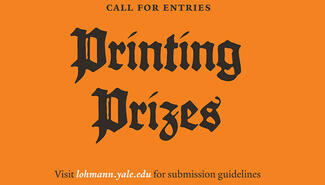April events and online exhibit celebrate lyric poetry in the world
“How does lyric poetry move through the world? What place does it have in our cultural, social, political worlds? And why do lyrics—whether understood as literary masterpieces or the words to our favorite songs—continue to touch us in both ‘body and soul’?”
These questions were a starting point for Ayesha Ramachandran, associate professor of Comparative Literature, when she curated “Lyric Thinking: Poetry in the World,” the 2022-23 Model Research Collection on view in Bass Library this academic year. Now, with a new online exhibit and three related events in April, she is bringing new perspectives to the collection and the questions it explores.
The Model Research Collection was introduced in 2019 to show students how a researcher might draw on library resources to investigate a research topic. Each year’s collection has a different topic, and a different faculty curator. For Ramachandran, the collection is “a constellation of ideas” and “a set of intellectual tentacles.” One of her goals, she said in an interview, is “to give students a sense of how expansively you can think about something that, when you start out, might seem pretty narrow.”
As a form, lyric poetry is generally short, has a musical or rhythmic quality, and expresses the poet’s personal emotions and view of the world. “There’s something very populist about lyric poetry,” Ramachandran said. “It’s the thing that animates song lyrics and the kinds of poems that people write to each other that are often not great, but are emotionally meaningful. It’s what motivates people to use those poems in weddings and in funerals. There’s also a way in which lyric poetry is baked into the quality of our lives. For people who are religious or have some devotional faith, lyric poetry is the backbone of liturgy and ritual incantation.”
Ramachandran’s scholarship focuses on 16th and 17th century literature and the moment in history that is often described as the beginning of modern lyric poetry. Over time, her interests have expanded. “I have been trying to think about a very old problem in literary study, which is how do we think about poetry in genuinely global terms?” she said. “When the library approached me about curating the Model Research Collection, I realized that this is actually an interesting problem for undergraduates because it touches on several key questions in the humanities—questions about high and low culture, and about how we access cultural traditions that seem alien from us.”
Selecting the 1,100 books (plus a handful of audiovisual resources) featured in “Lyric Thinking” was unexpectedly challenging. “I’m curious and I read widely, but a lot of what I found was new to me,” Ramachandran said.
Ramachandran selected a mix of works in original languages and works in translation. “I really wanted people to see, on the shelf, that languages are different, and poems come in many shapes and characters,” she said. “But I also wanted there to be enough translated material that people could browse and get a sense of something different that was also accessible.”
Creating the collection, Ramachandran experienced the kinds of new insights she hopes her students will find in the research process. For example, although she was aware of the connection between poetry and medicine, a collection of AIDS poetry struck her very differently in the time of COVID. “It really touched me, in part, because we’ve gone back to this moment of thinking about isolation and community and what does it mean to express the suffering of the body,” she said. “It reminds us that there have been many such moments in the past, sometimes limited to particular communities, and that poetry carries the traces of those voices in ways that other forms don’t.”
Through the display materials in Bass Library and the online exhibit, Ramachandran has been able to spotlight visual and material aspects of lyric poetry represented by rare books and other objects in Yale’s special collections. One featured object is a book of poems by Amir Khusrau, a medieval Indo-Persian poet. “These volumes were copied well into the eighteenth and nineteenth centuries,” she said. “So part of it is I wanted to make visible is this immense manuscript tradition of Persianate poetry, which ranged from what is present-day Turkey all the way across, through central Asia, South Asia, and into parts of what is today China. It was a rich, millennium-long tradition that we barely know about in the Anglophone world.”
In April, Ramachandran and other Yale colleagues will spotlight other new dimensions of “Lyric Thinking” with three events:
· April 4, 4:30 pm, Lyric Printing: A Demonstration and Conversation (Bass Library)
· April 10, 4 pm, Mondays at Beinecke, talk by Ayesha Ramachandran (Online even)
· April 17, 5 pm, Lyric Thinking with Peter Cole: A Festive Celebration (Bass Library)
—Patricia M. Carey



